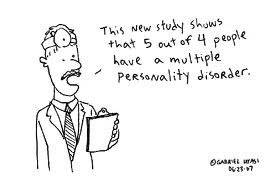


|
There was a little girl, who had a little curl The basic theoretical dynamic in multiple personality is that the person deals with conflicting feelings and thoughts by repressing them and compartmentalizing them so that certain kinds of feelings and thoughts are expressed in one personality or state of consciousness, and other conflicting feelings and thoughts are expressed in another personality, making it unnecessary to reconcile the different thoughts and feelings. Themes in famous novels also express the interest and curiosity we always have in unusual or extreme shifts in mood or behavior. For example, the story of "Dr. Jekyl and Mr. Hyde" is a classical description of two mutually contradictory personalities, one sensitive, compassionate and "good," the other violent, uncivilized and murderous. In the 1950s, the phenomenon of multiple personalities came to the attention of the general public in the form of a motion picture called "The Three Faces of Eve." It was based upon the treatment of a woman who appeared to manifest three separate personalities. It was followed later by "Sybil" and many other accounts of multiple personalities, some based on true cases, some entirely fictional. The number of personalities and the spectacular nature of the differences between personalities seemed to increase as time has passed. While multiple personality was a rare and unusual diagnosis prior to the 50s, in the 70s and 80s it became much more common. Some therapists thought it was necessarily associated with a history of child abuse. Experienced psychologists know that when there is a dramatic change in the frequency of a psychodiagnosis it is important to determine whether we are observing a real change in the occurrence of the disorder, whether it is due to a change in the diagnostic categories used in the field, or a change in the "popularity" of the diagnosis. It is an unfortunate fact that fashions come and go in the use of certain diagnostic categories, forms of treatment and theories of psychopathology, especially among less experienced therapists, who tend to jump onto a "diagnostic bandwagon." Many psychologists believe that some inexperienced or poorly trained therapists began to "look for" multiple personalities in their patients and viewed the "discovery" of many different personalities in their patients as an indication of their therapeutic skill and astuteness. If, in fact, a diagnosis of multiple personality is correct, treatment involves the integration of the fragmented parts of the personality. If that diagnosis is not correct, there is are serious consequences in an incorrect treatment plan, as described below. Every person has different moods, and may function differently in different situations or at different times. Every person has conflicts and may be torn between alternatives about how to handle a situation or problem. It is not uncommon for people to make comments such as, "He's a different man since.....etc." The fact that you may sometimes be quiet, sometimes gregarious, sometimes "up" or sometimes "down", sometimes patient and other times irritable does not mean that you have multiple personalities. In general it is the goal in psychotherapy to help a person integrate conflicting or contradictory feelings, impulses, thoughts, moods, conflicts and perceptions. The goal is to increase one's understanding of oneself, to heighten the awareness of our feelings, and to avoid repression or compartmentalization of thoughts, feelings and experiences. A therapist who is strongly motivated to "find multiple personalities" might inadvertently harm a patient by doing the opposite, namely by encouraging the patient to perceive conflicting feelings and thoughts as expressions of different personalities, thereby interfering with that integrative process. Hypnotherapy has been one psychotherapeutic procedures utilized to examine and treat multiple personality. This is a procedure that should not be used by an inexperienced therapist. It should only be considered for use by a well trained and experienced psychologist who has good clinical judgment. The proper use of hypnotherapy in these cases is to help integrate personality, not to reinforce the psychological compartmentalization that generates multiple personalities. (See the page on Hypnosis for information about selecting a hypnotherapist.) The conflict between powerful sexual impulses and moral, ethical or religious value systems may create disturbing personality problems that can be involved in the genesis of multiple personality. On the one hand, these value systems present a compelling template for acceptable behavior that is strongly reinforced by family, social, or religious institutions. Such value systems may successfully guide a person's behavior most of the time. On the other hand, there may be episodes when powerful sexual drives result in actions that are inconsistent with these value systems. Depending on variables in personality and life experience, such episodes may or may not create serious disturbing feelings of shame and guilt. If these feelings cannot be managed, the psychic pain may be resolved by a psychological compartmentalization of these conflicting modes of behavior. The result is an intermittent expression of a "sexual" personality that is in stark contrast to the "normal" personality. Similar conflicts may occur in handling aggressive impulses in a manner that is inconsistent with a persons strongly held value systems. Sometimes feelings of unworthiness based on low self esteem can play a role in the development of multiple personality. Problems of low self esteem can have many causes. Such problems can be related to unresolved conflicts involving sexual or aggressive impulses. They can also be related to feelings of abandonment or by negative messages conveyed from parental figures. Secondary problems may include depression, neglect of personal appearance, eating disorders or excessive weight gain. (See the page on weight control.) Low self esteem and dissatisfaction with personal appearance can contribute to the episodic assumption of a "different" personality that blocks out the negative elements in self image, or that compensates for such feelings in a pathological way. |
http://psychologydoc.com/multiple_personality.htm __________________________________________________________________________________________________________________________________________________________________________________________________________ |
No comments:
Post a Comment